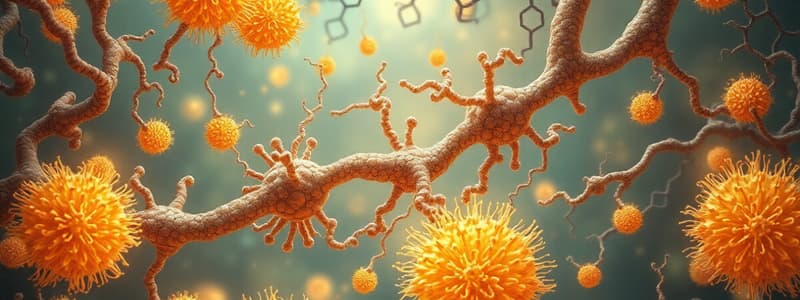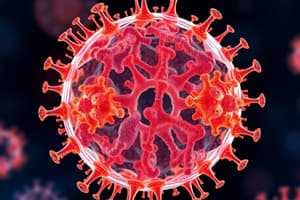Podcast
Questions and Answers
What is the primary function of enzymes in biochemical reactions?
What is the primary function of enzymes in biochemical reactions?
- To change the pH of the reaction
- To speed up biochemical reactions (correct)
- To increase the activation energy required
- To serve as a substrate for the reaction
What happens to an enzyme at extreme pH levels?
What happens to an enzyme at extreme pH levels?
- It requires more substrate
- It binds to more cofactors
- It becomes more active
- It gets denatured (correct)
Which stage of aerobic respiration produces the most ATP?
Which stage of aerobic respiration produces the most ATP?
- Fermentation
- Electron Transport Chain (correct)
- Krebs cycle
- Glycolysis
What type of inhibition occurs when a substance binds to the active site of an enzyme?
What type of inhibition occurs when a substance binds to the active site of an enzyme?
What is the role of NAD and FAD in metabolism?
What is the role of NAD and FAD in metabolism?
In prokaryotes, where does the Krebs cycle occur?
In prokaryotes, where does the Krebs cycle occur?
Which component of an enzyme contains the protein part without any cofactors?
Which component of an enzyme contains the protein part without any cofactors?
What initiates glycolysis in cellular respiration?
What initiates glycolysis in cellular respiration?
What is the primary product of the EMP pathway?
What is the primary product of the EMP pathway?
Which pathway primarily produces NADPH?
Which pathway primarily produces NADPH?
What type of organism uses light energy and CO2 for growth?
What type of organism uses light energy and CO2 for growth?
Which group of bacteria is optimal at temperatures around 10°C?
Which group of bacteria is optimal at temperatures around 10°C?
Which type of microbe is capable of growing without oxygen but prefers it?
Which type of microbe is capable of growing without oxygen but prefers it?
What is a characteristic of chemotrophic organisms?
What is a characteristic of chemotrophic organisms?
Which type of bacteria can grow optimally at temperatures above 80°C?
Which type of bacteria can grow optimally at temperatures above 80°C?
What is the primary chemical requirement for microbial growth?
What is the primary chemical requirement for microbial growth?
What occurs during the lag phase of microbial growth?
What occurs during the lag phase of microbial growth?
Which of the following best describes sterilization?
Which of the following best describes sterilization?
What is the typical countable range of CFUs for accurate assessment on an agar plate?
What is the typical countable range of CFUs for accurate assessment on an agar plate?
Which method is considered a direct measurement of microbial growth?
Which method is considered a direct measurement of microbial growth?
What is the primary purpose of antiseptics?
What is the primary purpose of antiseptics?
What does bacteriostasis refer to?
What does bacteriostasis refer to?
What consequence can sepsis cause after surgery?
What consequence can sepsis cause after surgery?
Joseph Lister's contribution to microbial control significantly focused on which method?
Joseph Lister's contribution to microbial control significantly focused on which method?
Which type of agent disrupts cell membranes and is commonly found in products like Lysol?
Which type of agent disrupts cell membranes and is commonly found in products like Lysol?
Which of the following microbes is most resistant to sterilization methods?
Which of the following microbes is most resistant to sterilization methods?
What is the process by which mRNA is converted into a protein?
What is the process by which mRNA is converted into a protein?
What characterizes dominant genes in terms of expression?
What characterizes dominant genes in terms of expression?
Which type of RNA carries the genetic code from DNA to the ribosomes?
Which type of RNA carries the genetic code from DNA to the ribosomes?
What fundamental unit of heredity is defined as a segment of DNA coding for specific proteins or RNA?
What fundamental unit of heredity is defined as a segment of DNA coding for specific proteins or RNA?
In which cellular compartment does transcription occur in eukaryotes?
In which cellular compartment does transcription occur in eukaryotes?
During transcription, which base in DNA is replaced by uracil in RNA?
During transcription, which base in DNA is replaced by uracil in RNA?
What is the function of a start codon in mRNA?
What is the function of a start codon in mRNA?
Which type of mutation results in a premature stop codon?
Which type of mutation results in a premature stop codon?
What is the typical mutation rate in DNA?
What is the typical mutation rate in DNA?
How does transformation occur in bacteria?
How does transformation occur in bacteria?
What effect does radiation have on DNA?
What effect does radiation have on DNA?
What does the Ames test measure?
What does the Ames test measure?
Which type of mutation is characterized as a single nucleotide change?
Which type of mutation is characterized as a single nucleotide change?
What is a characteristic feature of plasmids?
What is a characteristic feature of plasmids?
Flashcards are hidden until you start studying
Study Notes
Microbial Metabolism
- Metabolism encompasses all chemical reactions within a cell, including anabolism (building up molecules) and catabolism (breaking down molecules).
- Redox reactions involve the transfer of electrons:
- Oxidation is the loss of electrons.
- Reduction is the gain of electrons.
- Enzymes are proteins that accelerate biochemical reactions by lowering activation energy.
- Apoenzyme is the protein portion of an enzyme.
- Cofactor is a non-protein component required for enzyme function.
- Holoenzyme is the complete enzyme, consisting of the apoenzyme and cofactor.
- Enzymes are often named by adding "-ase" to the substrate or reaction they catalyze.
- Optimal pH and temperature are crucial for enzyme activity. Extremes can denature enzymes, rendering them ineffective.
- Enzyme inhibition can occur through:
- Competitive inhibition: A substance competes with the substrate for the active site.
- Allosteric inhibition: A substance binds to a site other than the active site, altering the enzyme's shape and reducing activity.
- NAD and FAD are electron carriers involved in metabolic reactions.
- NAD is reduced to NADH.
- FAD is reduced to FADH2.
- They transport electrons to the electron transport chain for ATP production.
- Aerobic respiration involves three stages:
- Glycolysis: Occurs in the cytoplasm, producing pyruvate.
- Krebs cycle: Occurs in the mitochondrial matrix (eukaryotes) or cytoplasm (prokaryotes), producing CO2.
- Electron Transport Chain (ETC): Occurs in the inner mitochondrial membrane (eukaryotes) or cell membrane (prokaryotes), producing ATP and water.
- ATP production:
- Glycolysis: 2 ATP
- Krebs cycle: 2 ATP
- ETC: ~34 ATP (prokaryotes) or ~36 ATP (eukaryotes)
- Total: ~38 ATP (prokaryotes) or ~36 ATP (eukaryotes)
- ATP synthase creates ATP by utilizing the proton gradient across a membrane during oxidative phosphorylation.
- Metabolic pathways involve various steps:
- EMP (Embden-Meyerhof-Parnas): Most common glycolytic pathway, producing pyruvate, ATP, and NADH.
- PPP (Pentose Phosphate Pathway): Produces NADPH and ribose-5-phosphate for nucleotide synthesis.
- ED (Entner-Doudoroff): Alternative glycolytic pathway, producing pyruvate, ATP, and NADPH, utilized by some bacteria.
- Fermentation allows cell regeneration of NAD+ when oxygen is unavailable, converting pyruvate into products like lactic acid or ethanol.
- Lipid and protein catabolism occur during the Krebs cycle.
- Types of organisms based on energy and carbon sources:
- Photoautotrophs: Use light energy and CO2 (e.g., plants, cyanobacteria).
- Chemoautotrophs: Use chemical energy and CO2 (e.g., some bacteria).
- Photoheterotrophs: Use light for energy but organic compounds for carbon (e.g., purple non-sulfur bacteria).
- Chemoheterotrophs: Use organic compounds for both energy and carbon (e.g., animals, fungi).
Microbial Growth
- Temperature groups of bacteria:
- Psychrophiles: Thrive at cold temperatures (below 15°C, optimal around 10°C).
- Psychrotrophs: Grow between 0–30°C, optimal around 20–30°C (spoil food in refrigerators).
- Mesophiles: Optimal growth at moderate temperatures, around 25–40°C (most human pathogens).
- Thermophiles: Thrive at warmer temperatures, 50–60°C.
- Hyperthermophiles: Can grow at extremely high temperatures, above 80°C, often found in hot springs.
- Physical and chemical requirements for microbial growth:
- Physical requirements: Temperature, pH (most bacteria grow best between pH 6.5 and 7.5), and osmotic pressure (salt concentration).
- Chemical requirements: Carbon, nitrogen, sulfur, phosphorus, trace elements (e.g., iron, magnesium), and oxygen (for some).
- Oxygen requirements of microbes:
- Obligate aerobes: Require oxygen.
- Obligate anaerobes: Cannot tolerate oxygen.
- Facultative anaerobes: Can grow with or without oxygen, but prefer oxygen.
- Aerotolerant anaerobes: Do not use oxygen but can tolerate its presence.
- Microaerophiles: Require lower levels of oxygen than present in the atmosphere.
- Thioglycolate broth supports an oxygen gradient, allowing bacteria to grow based on their oxygen needs.
- Microbial growth phases:
- Lag phase: Bacteria adapt to the environment, minimal growth.
- Log phase (exponential phase): Rapid bacterial growth and division.
- Stationary phase: Slowed growth due to nutrient depletion, death rate equals division rate.
- Death phase: Cells die at an accelerated rate due to harsh conditions.
- Colony-forming units (CFUs): Measure viable bacterial cells, with one CFU representing a cell or group of cells forming a colony.
- Countable range: Generally between 30 and 300 colonies on an agar plate for reliable counts.
- Direct and indirect microbial measurement methods:
- Direct methods: Counting colonies (plate counts), counting cells under a microscope, or using flow cytometry.
- Indirect methods: Measuring turbidity (cloudiness) in liquid culture, measuring metabolic activity, or dry weight.
Control of Microbial Growth
- Sterilization: Complete destruction of all forms of microbial life, including spores (e.g., autoclaving).
- Disinfection: Reducing pathogenic microorganisms on inanimate objects (e.g., bleach on surfaces).
- Sepsis: Presence of harmful microorganisms or their toxins in tissues.
- Degerming: Mechanically removing microbes from a limited area (e.g., handwashing).
- Antiseptic: Chemical agents used on living tissues to reduce microbial load (e.g., iodine on skin).
- Sanitization: Reducing microbial levels on inanimate objects to safe public health levels (e.g., cleaning utensils in restaurants).
- Biocide/Germicide: Agents that kill microorganisms (e.g., bleach).
- Asepsis: Absence of significant contamination (e.g., sterile techniques during surgery).
- Bacteriostasis: Inhibiting bacterial growth without killing the microbes (e.g., refrigeration).
- Joseph Lister's contribution: Pioneered the use of carbolic acid (phenol) to sterilize surgical instruments and clean wounds, reducing nosocomial infections.
- Nosocomial infections: Infections acquired in healthcare settings, often due to poor aseptic practices or weakened immune systems.
- Antimicrobial agents and their modes of action:
- Halogens (iodine, chlorine): Strong oxidizers and disinfectants.
- Phenolics: Disrupt cell membranes (e.g., Lysol).
- Heavy metals (silver, copper): Inhibit microbial growth by denaturing proteins.
- Surface-active agents (surfactants): Lower surface tension, making microbes easier to remove (e.g., soaps).
- Aldehydes: Highly effective disinfectants that crosslink proteins (e.g., formaldehyde).
- Most resistant microbes:
- Prions: Proteinaceous infectious particles, highly resistant to sterilization methods.
- Endospores: Bacterial spores (e.g., Bacillus and Clostridium species), highly resistant.
- Mycobacteria: Have waxy cell walls that resist many disinfectants.
- Gram-negative bacteria: Their outer membrane makes them more resistant to some antimicrobial agents.
Microbial Genetics
- Genes: Segments of DNA coding for specific proteins or RNA molecules.
- Genomes: The complete set of genetic material (DNA) in an organism.
- Genotype: The genetic makeup of an organism.
- Phenotype: The observable characteristics or traits of an organism, influenced by genotype and environment.
- Flow of genetic information: DNA -> RNA -> protein (expression).
- Dominant genes: Express their traits even with only one copy present.
- Recessive genes: Require two copies for trait expression.
- mRNA (messenger RNA): Carries the genetic code from DNA to ribosomes for protein synthesis.
- tRNA (transfer RNA): Brings amino acids to the ribosome during protein synthesis, matching them to codons on mRNA.
- Transcription: Copying DNA into RNA (occurs in the nucleus of eukaryotes or cytoplasm of prokaryotes).
- Enzyme involved: RNA polymerase.
- Product: mRNA.
- Translation: Converting mRNA into a protein (occurs in the ribosome).
- Biomolecules involved: mRNA, tRNA, rRNA, amino acids.
- DNA to RNA conversion:
- Thymine (T) in DNA is replaced by uracil (U) in RNA.
- Codons: Three-nucleotide sequences on mRNA coding for specific amino acids.
- Start codon: AUG (methionine).
- Process of translation:
- As mRNA moves through the ribosome, each codon is read and matched with the appropriate tRNA carrying its corresponding amino acid.
- Amino acids are linked to form a polypeptide chain (protein).
- Mutations: Changes in the DNA sequence, occurring spontaneously or induced by external factors (e.g., radiation).
- Typical mutation rate: Around 1 in 10^9 nucleotides.
- Types of mutations:
- Point mutation: Single nucleotide change.
- Frameshift mutation: Insertion or deletion of nucleotides, altering the reading frame.
- Silent mutation: Does not affect the protein sequence.
- Missense mutation: Results in a different amino acid.
- Nonsense mutation: Creates a stop codon, truncating the protein.
- Radiation and mutation repair:
- Radiation (e.g., UV light): Causes thymine dimers, disrupting DNA replication.
- DNA repair mechanisms: Photolyases (light repair) and excision repair systems correct radiation damage.
- Ames test: Identifies potential mutagens by measuring whether a chemical increases mutation rates in Salmonella bacteria.
- Gene transfer in bacteria:
- Transformation: Uptake of naked DNA from the environment.
- Conjugation: Direct transfer of DNA between bacteria via a pilus.
- Transduction: Transfer of DNA via a virus (bacteriophage).
- Genetic transformation and Streptococcus pneumoniae:
- Frederick Griffith discovered genetic transformation through experiments with Streptococcus pneumoniae.
- Dead virulent bacteria could "transform" non-virulent bacteria into virulent ones by transferring DNA.
- Plasmids: Small, circular DNA molecules separate from chromosomal DNA in bacteria.
Studying That Suits You
Use AI to generate personalized quizzes and flashcards to suit your learning preferences.




